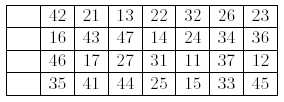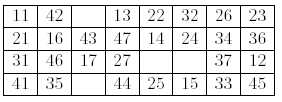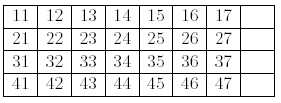标签:



#include<cstdio>
#include<cstring>
#include<string>
#include<iostream>
#include<sstream>
#include<algorithm>
#include<utility>
#include<vector>
#include<set>
#include<map>
#include<queue>
#include<cmath>
#include<iterator>
#include<stack>
using namespace std;
const int INF=1e9+7;
const int eps=0.0000001;
typedef __int64 LL;
const LL mod=1000007;
int maze[4][8];
LL Hash[mod];
LL base[32];
struct node
{
int px[4],py[4]; //保存四个空位
int S[4][8]; //整个图
int dist;
}Nod[100005];
int id;
queue<int> que;
int goal[4][8]={ //最终状态
{ 11,12,13,14,15,16,17,0 },
{ 21,22,23,24,25,26,27,0 },
{ 31,32,33,34,35,36,37,0 },
{ 41,42,43,44,45,46,47,0 }
};
LL G;
void GetBase() //打出2^i
{
base[0]=1;
for(int i=1;i<32;i++) base[i]=base[i-1]*2;
}
int GetId(int x,int y){ return x*8+y; }
void SetHead()
{
for(int i=0;i<4;i++)
for(int j=1;j<8;j++)
{
int a=maze[i][j]/10;
int b=maze[i][j]%10;
if(b==1) { maze[a-1][0]=maze[i][j]; maze[i][j]=0; } //把11,21,31,41挑出来
}
}
LL GetHash(int S[4][8])
{
LL ret=0;
for(int i=0;i<4;i++)
for(int j=0;j<8;j++) ret+=(LL)S[i][j]*base[GetId(i,j)]; //得到哈希值
return ret;
}
bool InsertHash(LL val)
{
LL v=val%mod;
while(Hash[v]!=-1&&Hash[v]!=val) v=(v+10)%mod; //判重
if(Hash[v]==-1){ Hash[v]=val; return true; } //可以插入
return false;
}
void init()
{
memset(Hash,-1,sizeof(Hash));
while(!que.empty()) que.pop();
id=0;
G=GetHash(goal);
int k=0;
int cur=id++;
for(int i=0;i<4;i++)
for(int j=0;j<8;j++)
{
Nod[cur].S[i][j]=maze[i][j];
if(maze[i][j]==0){ Nod[cur].px[k]=i; Nod[cur].py[k++]=j; } //得到最初的状态
}
Nod[cur].dist=0;
que.push(cur);
}
void Change_S(node& e,int x,int y,int pick,int k)
{
for(int i=0;i<4;i++)
for(int j=0;j<8;j++)
if(e.S[i][j]==pick)
{
e.S[i][j]=0;
e.S[x][y]=pick;
e.px[k]=i; e.py[k]=j;
return;
}
}
void AddNode(int now)
{
node& e=Nod[now];
for(int i=0;i<4;i++)
{
int x=e.px[i];
int y=e.py[i];
int pre=e.S[x][y-1];
if(pre==0) continue; //也是空位不管
int a=pre/10;
int b=pre%10;
if(b==7) continue; //不能是*7
int pick=pre+1;
node t=e;
t.dist++;
Change_S(t,x,y,pick,i);
LL nowG=GetHash(t.S);
if(!InsertHash(nowG)) continue; //能否插入
int cur=id++;
Nod[cur]=t;
que.push(cur);
}
}
int solve()
{
SetHead();
init();
while(!que.empty())
{
int now=que.front(); que.pop();
node& e=Nod[now];
LL nowG=GetHash(e.S);
if(nowG==G) return e.dist; //找到解
AddNode(now);
}
return -1;
}
int main()
{
int T;
GetBase();
cin>>T;
while(T--)
{
memset(maze,0,sizeof(maze));
for(int i=0;i<4;i++)
for(int j=1;j<8;j++) cin>>maze[i][j];
printf("%d\n",solve());
}
return 0;
}
标签:
原文地址:http://www.cnblogs.com/wust-ouyangli/p/5660613.html